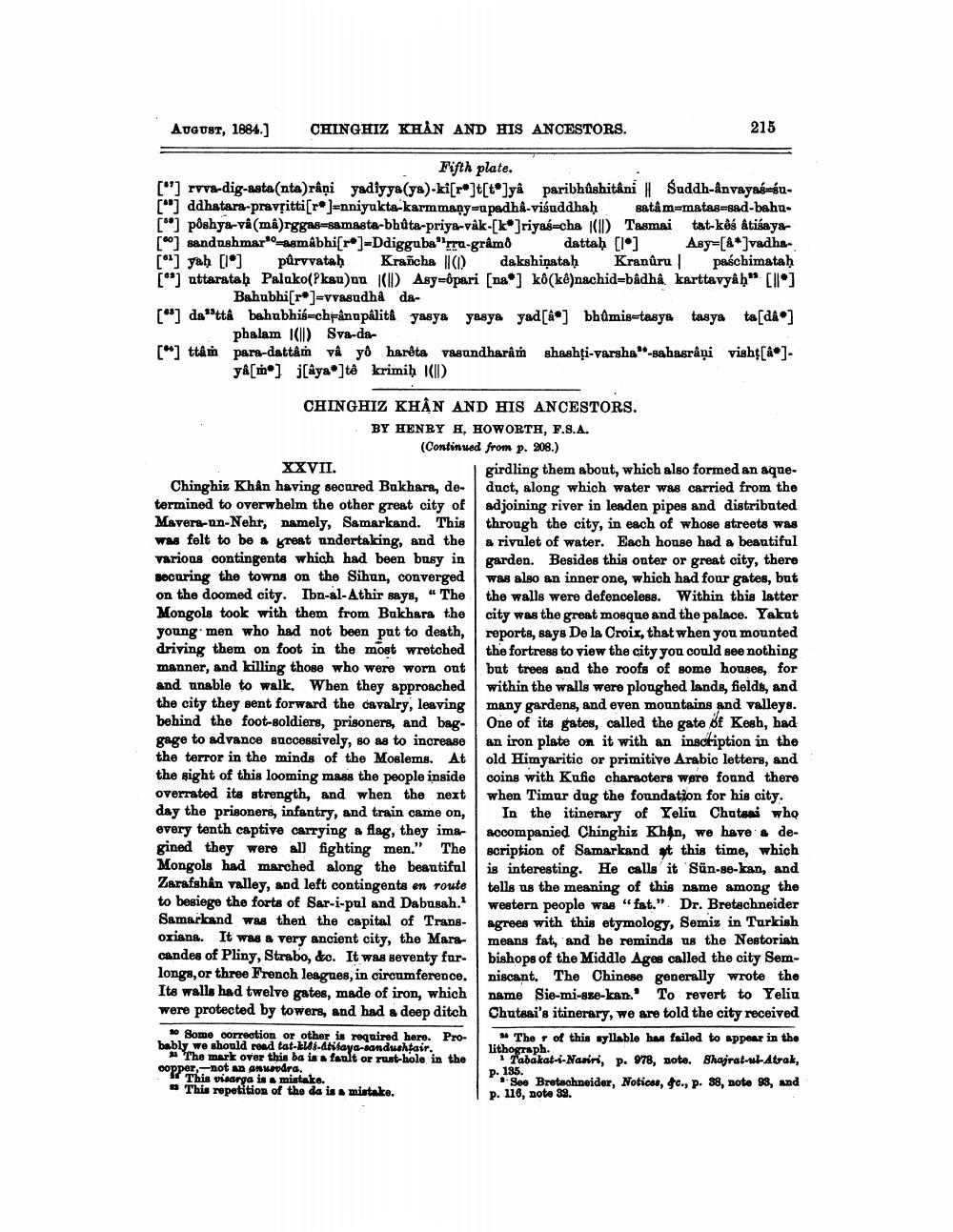________________
August, 1884.)
CHINGHIZ KHÅN AND HIS ANCESTORS.
215
Fifth plate. ["] ryva-dig-asta(nta)râņi yadiyya(ya)-ki[r*]t[t"]yâ paribhúshitani # Suddh-ânvayas=su["] ddhatara-pravritti[r]=nniyukta-karmmaạy-upadha-visuddhah satam-matas-sad-bahu. [") påshya-vå (mârggas=samasta-bhůta-priya-vak-[k]riyas-cha (1) Tasmai tat-kês âtisaya[°C] sandushmar"-asmabhi[r]-Ddiggubarra-grâm dattah [lo] Asy=[4* ]vadha["] yah (1) půrvvatab Krañcha (1) dakshiņatah Kranurul paschimataḥ [") uttaratab Paluko(Pkau)nu (ID) Asy-pari [na®) kó(kê)nachid=bådhå karttavyâh" [llo]
Bahubhi[r]=vvasudhå da["] da"tta bahubhis-chFânapálità pasya yasya yad[&•] bhůmis-tasya tasya tada ]
phalam il) Sva-da["] ttam para-dattâm và yê harêta vasundharan shashți-varsha"-sahasrâņi visht[&•]
yå[**] jCâyatê krimih ID
CHINGHIZ KHÂN AND HIS ANCESTORS.
BY HENRY H, HOWORTH, F.S.A.
(Continued from p. 208.) XXVII.
girdling them about, which also formed an aqueChinghiz Khân having secured Bukhare, de- duct, along which water was carried from the termined to overwhelm the other great city of adjoining river in leaden pipes and distributed Mavers-un-Nehr, namely, Samarkand. This through the city, in each of whose streets was was felt to be a great undertaking, and the rivulet of water. Each house had a beautiful various contingents which had been busy in garden. Besides this onter or great city, there securing the towns on the Sihun, converged was also an inner one, which had four gates, but on the doomed city. Ibn-al-Athir says, “The the walls were defenceless. Within this latter Mongols took with them from Bukhara the city was the great mosque and the palace. Yakut young men who had not been put to death, reports, says De la Croix, that when you mounted driving them on foot in the most wretched the fortress to view the city you could see nothing manner, and willing those who were worn out but trees and the roofs of some houses, for and unable to walk. When they approached within the walls were ploughed lande, fields, and the city they sent forward the cavalry, leaving many gardens, and even mountains and valleys. behind the foot-soldiers, prisoners, and bag. One of its gates, called the gate of Kesh, had gage to advance successively, so as to increase an iron plate on it with an insctiption in the the terror in the minds of the Moslems. At old Himyaritic or primitive Arabic letters, and the sight of this looming mass the people inside coins with Kufic characters were found there overrated its strength, and when the next when Timur dag the foundation for his city. day the prisoners, infantry, and train came on, In the itinerary of Yelin Chotsai who every tenth captive carrying a flag, they ima accompanied Chinghiz Khen, we have a degined they were all fighting men." The scription of Samarkand at this time, which Mongols had marched along the beautiful is interesting. He calls it 'Sün-ne-kan, and Zarafshin valley, and left contingents en route tells us the meaning of this name among the to besiege the forts of Sar-i-pul and Dabusah." western people was "fat." Dr. Bretachneider Samarkand was then the capital of Trans- agrees with this etymology, Semiz in Turkish oriana. It was a very ancient city, the Mara- means fat, and be reminds us the Nestorian candes of Pliny, Strabo, do. It was seventy for- bishops of the Middle Ages called the city Semlongs, or three French leagues, in circumference. niscant. The Chinese generally wrote the Its walls had twelve gates, made of iron, which name Sie-mi-sze-kan. To revert to Yeliu were protected by towers, and had a deep ditch Chutsai's itinerary, we are told the city received
• Some correction or other is required here. Pro- * Ther of this syllable has failed to appear in the bably we should read tat-kus.Naya-sanduetair... The mark over this ba is a tault or rust-hole in the
thorabokat-i-Nasiri, p. 078, noto. Shajrat-ul-Atrak, oopper, - not an anupudra. This visarga is a mistake.
P.-S.co Bretschneider, Notico, fc., p. 88, note 98, and * This repetition of the da is a mistake.
p. 116, note 32.




